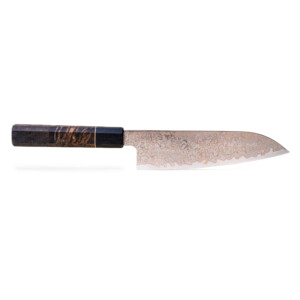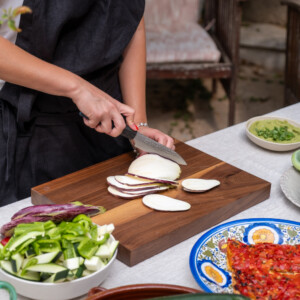For those starting their journey into the world of Japanese kitchen knives, one aspect that can seem incredibly daunting is understanding the grading system. Unlike their western counterparts, Japanese knives adhere to a unique grading scale that takes into account multiple factors such as steel composition, heat treatment processes, and craftsmanship. This intricate grading system is a reflection of the rich cultural heritage and unwavering pursuit of perfection that has long defined Japanese bladesmithing.
In this comprehensive guide, we will demystify the Japanese knife grading system, exploring its origins, the various grades, and what each level signifies in terms of quality, performance, and value. By the end, you’ll be equipped with the knowledge to make an informed decision when investing in a Japanese kitchen knife that meets your culinary needs and preferences.
The Origins of the Japanese Knife Grading System
The roots of the Japanese knife grading system can be traced back to the ancient art of sword-making, where smiths meticulously crafted blades for samurai warriors. The process of forging these legendary swords required a deep understanding of metallurgy, heat treatment, and intricate techniques passed down through generations.
As the demand for kitchen knives grew, bladesmiths adapted their sword-making skills to create cutting tools for culinary purposes. The grading system evolved as a means of classifying these knives based on their quality, ensuring that the rich tradition of Japanese bladesmithing was upheld.
The Three Primary Grades: An Overview
At the heart of the Japanese knife grading system lie three primary grades: Shirogami (White Steel), Awagami (Blue Steel), and Hagane (Carbon Steel). Each grade is distinguished by its steel composition, heat treatment process, and resulting properties.
1. Shirogami (White Steel)
Shirogami, or white steel, is the most basic and affordable grade of Japanese knives. These knives are crafted from carbon steel with a relatively low carbon content, typically ranging from 0.6% to 0.7%. While not as hard or durable as higher grades, Shirogami knives are known for their excellent edge retention and ease of sharpening.
2. Awagami / Aogami (Blue Steel)
Awagami, or blue steel, is the intermediate grade in the Japanese knife hierarchy. These knives are made from carbon steel with a higher carbon content, usually between 0.7% and 1.2%. The increased carbon content results in a harder blade that can maintain a sharper edge for longer periods compared to Shirogami knives. Awagami knives also exhibit a distinct blue hue due to the heat treatment process.
3. Hagane (Carbon Steel)
Hagane, or carbon steel, represents the highest grade of Japanese knives. These blades are forged from high-carbon steel, with carbon content typically ranging from 1.2% to 1.5%. The combination of high carbon content and meticulous heat treatment results in an exceptionally hard and durable blade capable of achieving and retaining a razor-sharp edge. Hagane knives are prized for their superior cutting performance and longevity.
Sub-Grades and Special Designations
Within each primary grade, there exist sub-grades and special designations that further refine the classification of Japanese knives. These sub-grades take into account additional factors such as the specific steel alloy composition, heat treatment methods, and the level of craftsmanship involved.
1. Honyaki
Honyaki is a revered sub-grade reserved for knives crafted entirely from a single piece of high-carbon steel. This labor-intensive process involves folding and forging the steel multiple times, resulting in a blade with exceptional strength, hardness, and a distinct damascus-like pattern. Honyaki knives are highly prized for their superior quality and are often considered works of art.
2. Kasumi
Kasumi is a designation given to knives that feature a distinct visual contrast between the cutting edge and the blade’s body. This effect is achieved through a specialized heat treatment process that creates a hardened, razor-sharp edge while maintaining a softer, more flexible spine. Kasumi knives are prized for their excellent edge retention and durability.
3. Damascus
Damascus knives, or damascus steel knives, are characterized by their intricate, wavy patterns that are achieved by forging together multiple layers of different steel types. This process not only creates a visually stunning blade but also enhances the knife’s strength and cutting performance. Damascus knives are highly sought after for their beauty and superior quality.


4. Cladded
Cladded knives, also known as san-mai knives, feature a hard, high-carbon steel cutting core that is sandwiched between layers of softer, more flexible steel. This construction combines the benefits of a hard, durable edge with a flexible and resilient spine, resulting in a knife that is both high-performing and relatively easy to maintain.
Understanding Heat Treatment and Hardness
One of the key factors that determine a Japanese knife’s grade is the heat treatment process it undergoes. Heat treatment involves carefully controlled heating and cooling cycles that alter the molecular structure of the steel, resulting in varying degrees of hardness and durability.
Hardness is typically measured on the Rockwell Hardness Scale (HRC), with higher values indicating greater hardness. Japanese knives can range from 58 HRC for entry-level Shirogami knives to an impressive 64-66 HRC for top-tier Hagane blades.
It’s important to note that while harder blades can achieve and maintain sharper edges, they are also more brittle and susceptible to chipping or cracking if not used and maintained properly. Softer blades, on the other hand, are more forgiving and less prone to chipping but may require more frequent sharpening.
Craftsmanship and Tradition
Beyond the technical aspects of steel composition and heat treatment, the Japanese knife grading system also accounts for the level of craftsmanship and adherence to traditional techniques. Many renowned bladesmiths in Japan have spent decades, or even lifetimes, perfecting their skills, following time-honored methods passed down through generations.
Knives crafted by these master bladesmiths are often considered works of art, with each blade bearing the unique signature of the smith’s expertise. The level of craftsmanship involved can influence the knife’s grading, with blades created by highly respected smiths commanding a premium in the market.
Choosing the Right Grade for Your Needs
With a deeper understanding of the Japanese knife grading system, you can now make an informed decision when selecting a knife that aligns with your culinary needs, skill level, and budget. For home cooks and those seeking an affordable entry into the world of Japanese knives, Shirogami (white steel) knives can be an excellent choice. While not as hard or durable as higher grades, these knives offer excellent edge retention and are relatively easy to sharpen, making them a practical option for everyday use.
If you’re an avid home cook or a professional chef seeking a balance between performance and value, Awagami (blue steel) knives may be the ideal middle ground. These knives offer enhanced hardness and edge retention compared to Shirogami, while still being relatively affordable.
For those seeking the pinnacle of cutting performance and longevity, Hagane (carbon steel) knives are the ultimate choice. These high-carbon blades are exceptionally hard, durable, and capable of achieving and maintaining razor-sharp edges. However, they also command a premium price and require proper care and maintenance to prevent chipping or dulling.
Additionally, if you value the artistry and tradition behind Japanese bladesmithing, consider investing in knives from renowned smiths or those bearing special designations like Honyaki, Kasumi, or Damascus. These blades not only offer exceptional performance but also represent the rich cultural heritage of Japanese knifemaking.
Navigating the intricate world of the Japanese knife grading system can be a daunting task, but with the knowledge gained from this comprehensive guide, you are now better equipped to make an informed decision. Remember, the grade of a knife is not the sole determinant of its quality or suitability for your needs. Factors such as intended use, maintenance requirements, and personal preferences should also be taken into consideration.
By understanding the origins, grades, and nuances of the Japanese knife grading system, you can appreciate the time-honoured traditions and craftsmanship that have shaped these exceptional blades. Whether you’re a home cook seeking a reliable workhorse or a professional chef in pursuit of the ultimate cutting tool, the perfect Japanese knife awaits, ready to improve your culinary experience to new heights.


































